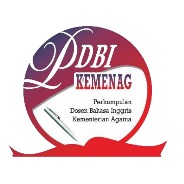Undergraduate Students’ Morphological Awareness and Difficulties in EFL Class
Abstract
Students' vocabulary knowledge is related to their morphological awareness, which plays an essential role in word comprehension and vocabulary development. This case study is aimed at describing undergraduate students’ morphological awareness and difficulties in morpheme identification and word relationship. This study employed the MAT test in two analytical tests. The Morpheme Identification Test is used to measure how well first-year college students can analyze and break down complicated words into their smaller meanings. Meanwhile, the Word Relation Test is administered to measure undergraduate students’ awareness of relations among base or root words and their inflected or derived forms. An interview was used to support the results of the tests. The result showed that the students performed better in breaking down inflected forms than those in derived forms. As in the Word Relation Test, it was discovered that the students had done better in identifying morphologically related word pairs. There were three types of difficulties in the morpheme identification test. The first was in breaking down complex words into smaller morphemes; the second was in stating the meaning of each smaller morpheme, especially affixes; and the third was in categorizing the complex words into inflected or derived forms.
Keywords
Full Text:
PDFReferences
Akbulut, D. F. (2017). Effects of .Morphological Awareness on Second Language Vocabulary Knowledge. Journal of Language. and Linguistic Studies, 13(1), 10-26.
Allen, A. A., & Lembke, E. S. (2022). The effect of a morphological awareness intervention on early writing outcomes. Learning Disability Quarterly, 45(2), 72-84.
Alsaeedi, A. W. (2017). The Role of Morphological .Awareness in Vocabulary Acquisition in English of Saudi EFL Learners. Seattle Pacific University: Seattle Pacific Library.
Anderson, C. (2018). Essential of Linguistics. Canada: McMaster University.
Apel, K., & Werfel, K. (2014). Using Morphological Awareness, Instruction to Improve Written Language Skills. Language, Speech and Hearing Services in Schools, 45, 251-260.
Asaad, H. Q. M., & Shabdin, A. A. (2021). The predictive role of morphological awareness and productive vocabulary knowledge in L2 postgraduate students’ academic writing. Eurasian Journal of Applied Linguistics, 7(1), 24-44.
Aydin, F., & Yildirim, O. (2017). A Study on. the Morphological Awareness of Intermediate Level Adult Turkish EFL Learners. Journal of English Language and Education, 3(2).
Badawi, M. F. A. (2019). The Effect of Explicit English Morphology Instruction on EFL Secondary School Students' Morphological Awareness and Reading Comprehension. English Language Teaching, 12(4), 166-178.
Larsen, K. (2022). Seeing Double. Mythlore, 40(2), 139-169.
Collins, G., Wolter, J. A., Meaux, A. B., & Alonzo, C. N. (2020). Integrating morphological awareness in a multilinguistic structured literacy approach to improve literacy in adolescents with reading and/or language disorders. Language, Speech, and Hearing Services in Schools, 51(3), 531-543.
Creswell, J. W. (2013). Qualit.ative inquiry and research design: Choosing among five approaches. Thousand Oaks, CA: Sage.
Jiang, Y., Kuo, L., & Sonnenburg-Winkler, S. L. (2015). Morphological Awareness and Reading Comprehension: A Qualitative Study with Adult EFL Learners. International Journal of Language and Linguistics, 2(5), 18–26.
Jiang, Y. L. B., & Kuo, L. J. (2019). The development of vocabulary and morphological awareness: A longitudinal study with college EFL students. Applied Psycholinguistics, 40(4), 877-903.
Jornlin, M. (2015). The Role of Morphological Awareness and Learning to read: A Cross-Language Perspective. Educational Psychologist, 41, 161-180.
Josiah, U. E., & Udoudom, J. C. (2012). Morphophonemic Analysis of Inflectional Morphemes in English and Ibibio Nouns: Implications for Linguistic Studies. Journal of Education and Learning, 1(2), 72–81. https://doi.org/10.5539/jel.v1n2p72
Li, L., Li, R., & Wu, X. (2020). The Reciprocal Relation between Morphological Awareness and Spelling in Chinese: A Longitudinal Study of Primary School Students. Plos One. https://doi.org/10.1371/journal.pone.0243050
Leu, T. (2020). The status of the morpheme. In Oxford Research Encyclopedia of Linguistics.
Mahnoosh, H., Rezail, M., J., & Mazdayasna, G. (2017). .Dynamic assessment of morphological awareness in the EFL context. Cogent Education, 4 (1), 1-14.
Mann, A., V. (2000). Reading Ability and Sensitivity to Morphological Relation. Research Gate, 1(3), 191-218. DOI: 10.1023/A:1008136012492
Nuril, S., Brilian, A., Safitri, M., Firdaus, R., Evansam, G. R., & Siswanto, A. (2017). Morpheme Analysis of English Language. JOSAR, 2(1).
Qiao, S., Yeung, S. S. S., Shen, X., & Chu, S. K. W. (2022). The effects of a gamified morphological awareness intervention on students' cognitive, motivational and affective
Rabadi, R. I. (2019). Morphological Awareness and Vocabulary Knowledge among English Language Learners. Arab World English Journal (AWEJ) Volume, 10.
Sarfraz, S., Tariq, U., & Abbas, A. (2018). Effectiveness of Morphological Awareness in English Writing Composition of Pakistani Students at the Undergraduate Level-Case Study. Journal of Education and Practice, 9(19).
Somathasan, M. (2018). The Study of Affixes (Prefixes and Suffixes): An ESL and Innovative Approach. International Journal of Applied Research, 4(11), 01-05.
Utami, S. H., & Mujadidah, M. (2021). An Analysis of English Education Students’ Morphological Awareness: Identification and Structure Awareness. JEET: Journal of English Education and Teaching, 5(3), 381-393
Zhang, H. (2021). The longitudinal effect of morphological awareness on higher-order literacy skills among college L2 learners. Contemporary Educational Psychology, 65, 101969.
DOI: http://dx.doi.org/10.29240/ef.v7i1.5785
Refbacks
- There are currently no refbacks.
Copyright (c)
INDEXED BY:
 This work is licensed under a Creative Commons Attribution-NonCommercial-ShareAlike 4.0 International License
This work is licensed under a Creative Commons Attribution-NonCommercial-ShareAlike 4.0 International License
@ ENGLISH FRANCA : Academic Journal of English Language and Education
Jl. Dr. AK Gani No 1 Dusun Curup, Rejang Lebong Regency, Bengkulu Province, Indonesia, 39119.
Dr. Eka Apriani, M.Pd., email: efranca@iaincurup.ac.id, eka.apriani@iaincurup.ac.id.




.png)












